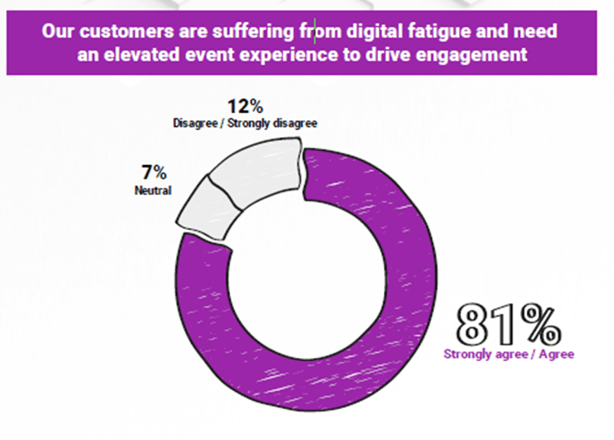Virtual events. You know them, you love them, you watch 15 in a row, and you vow never to see another digital event again. And repeat.
Virtual events offer many benefits for both marketers and consumers, including cost-effectiveness and accessibility. But everything isn't always right as roses. Sometimes it's less like roses, and more like nettles.

But digital fatigue is a real issue. We found in our B2B State of B2B Digital Event Experience 2023, in collab with Jugo, that 81% of US CMOs believe their customers are suffering from digital fatigue and need an elevated event experience to drive and maintain engagement.
60% of CMOs in the UK and Europe believe that customers are experiencing digital fatigue. While clearly still an issue, the findings suggest that this may be a larger problem for US marketers.
I do think digital fatigue is a thing. With so many people using the hybrid model now they seem to cram more virtual conferences into their working day and find it hard to engage in events in that format.
Hannah Campbell, Event Marketer & Executive Operations Manager, Google
Digital fatigue refers to the mental exhaustion and disengagement experienced by people who are required to use multiple digital tools and apps simultaneously, such as juggling processes across a dozen enterprise platforms while still meeting performance and productivity expectations.
This is different from simply using a smartphone while watching TV. The problem has been exacerbated by the pandemic, which forced marketing to rely solely on digital channels.
Unfortunately, many companies took these channels for granted, delivering the same content experiences, webinars, and events in the same way year after year.

This created a new problem because audiences are now inundated with digital experiences, with a 135.57% increase in digital experiences delivered between 2019 and 2021.
As a result, marketers face serious competition for the time and attention of their audiences. Experiences that fail to engage or feel repetitive only add to digital fatigue.
Today, audiences want more.
But let's have a quick look at why audiences are experiencing digital fatigue. Starting with:
Digital event overload
Due to the pandemic, there was a significant increase in the number of digital events being held. However, the resulting surge in volume left attendees feeling overwhelmed and fatigued from the constant stream of virtual content.
Monotony and screen fatigue
Prolonged exposure to digital events can cause screen fatigue, eye strain, and reduced engagement with the content. Attendees often spend long hours sitting in front of their screens, making digital events monotonous and exacerbating the aforementioned issues.
Technical and user experience issues.
Experiencing technical and user-related issues during an event can contribute to event fatigue. For example, poor internet connectivity, audio or video problems, or challenges with accessing the event platform can exacerbate the issue.
For more reasons leading to digital fatigue, check out our B2B State of B2B Digital Event Experience 2023, in collab with Jugo!
To help marketers assist consumers in avoiding digital fatigue, there are several strategies that can be implemented:
- Customisation for the user: Digital events and experiences should be designed to offer multiple options for interaction and customization. By allowing users to choose their own adventure, they can find the information they want, learn at their own pace, and get more from the experience. This can help users avoid the feeling of being overwhelmed by the content.
- More interactive content and messaging: Interactive content can create more engagement with customers and keep them interested in what you’re selling. Utilizing AR and VR channels, or social media to create contests, challenges, and more can provide an engaging experience without overwhelming the audience.
- Shorter sessions: Keeping individual event sessions and entire webinars to 60 minutes or less can make audience engagement much easier and can help to prevent digital fatigue. Delivering valuable content in bite-sized chunks can keep users engaged and interested in the experience.
- Willingness to experiment: Being willing to experiment with new ideas and strategies can help keep your digital events fresh and engaging for your audience. Experimenting with personalisation, humour, and new engagement tactics can help to prevent digital fatigue and keep your audience interested.
- Omnichannel strategy: Offering a variety of content formats and distribution channels can help to intrigue and engage different audiences. Considering the best format for each piece of content, from textual and visual to audio-based content, can provide users with options to suit their consumption habits. Using an omnichannel strategy for distribution can help to reach a larger audience, but it is important to remember that quality content is key.
